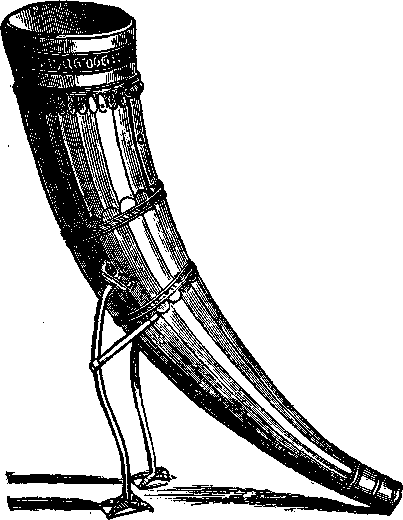Ancient Irish Horn
From the Dublin Penny Journal, Vol. 1, No. 10, September 1, 1832
From a very early period in England, even before the arrival of the Normans, it was not unusual to transfer inheritances by the gift of some implement that was well known to have belonged to the donor or grantor, and this too, sine scriptis, or without writing or charter, but simply by word of mouth; the lands thus held were either in Frank Almoigne, or in Fee, or in Serjeantry. Ingulph, Abbot of Croyland, states this to have been a frequent mode of conveying estates in the Conqueror's time, and that the implements given in lieu of a charter were usually the sword, or helmet, or Horn, or cup of the Lord or donor, and that many tenements were held by a spur, a scraper, a bow; and some by an arrow. Hence originated the Charter Horns, which appear to have been the implements most commonly used on those occasions, and of which there are many of great antiquity still preserved in England;- as the Horn of Ulphus, made of ivory, and now preserved in the vestry of the church of York, which was given to that church in token of his bestowing upon God and St. Peter all his lands, tenements, &c. The Pusey Horn, first given with the village of that name to William Pusey by King Canute. The Borstal Horn, Lord Bruce's Horn, Mr. Foxlowe's Horn, the Horn of Corpus Christi College, &c. These Horns were sometimes hunting Horns, sometimes drinking horns, and frequently adapted to both purposes, as has been and is still not unusual with hunters. Thus Chaucer,
"Janus sits by the fire with double berde,"And drinketh of his bugle horn the wine."
(Frankl. Tale. ver. 2809.)
As this custom was practised by the Danes in England, we may conclude that it equally prevailed among the same people in Ireland; but be that as it may, there is proof that it was used by the Anglo Norman settlers at a very early period. It would appear from the will of Thomas the7th Earl of Ormond, dated July 31, 1515, that it was by the gift of a Horn that the noble house of Butler first acquired their estates or honors, either on the appointment by Henry the II. in 1177, of Theobald, the first of the family, Butler of Ireland, or on the creation of the first Earl of Ormond by Edward the First when the county of Tipperary was made Palatine. The passage in the will is curious;-viz. "Item, when my Lord my father, whose soul God assoile, left and delivered unto me a lytle white Horne of ivory, garnished at both thends with gold, and corse thereunto of white sylke, barred with barres of gold and a tyret (turret) of gold thereupon, which was myne aunces-tours at fyrst time they were called to honour, and hath sy-then continually remained in the same blode, for which cause, my said lord and father commanded me upon his blessing, that I should do my devoir to cause it to contynue still in my blode as far furth as that might lye in me soo to be doone to the honour of the same blode. Therefore for the accomplishment of my seid father's will as far as it is in me to execute the same, I wool that my executors," &c. &c.

This Horn does not we believe now exist: but we present our readers with a representation of one of the same kind now preserved in the museum of Trinity college, to which it was presented by the late Mr. Kavanagh of Borris, the lineal descendant of the last kings of Leinster.
Our Irish Horn in its size and general appearance is not unlike some of those preserved in England. It is of ivory, has sixteen sides and is mounted with brass, indifferently gilt,-its height about sixteen inches. Round the mouthpiece is the following inscription in Gothic letters,
Tiguranius O'Laban me fecit Deo gracia, ihe.
That is, "Tiguranius (or Tighernan) O'Lavan made me for the love of God."
This horn has been usually called the Charter Horn; but on what evidence we cannot say, for nothing is known of its history. From the inscription it appears to have belonged originally to the Laffan family, which was of great respectability in the counties of Kilkenny and Tipperary, and its use was evidently that of a drinking cup.
General Vallancey has exhibited an extraordinary want of antiquarian skill in supposing this Horn to be of the fifth century! whereas its age cannot possibly be higher than the fourteenth, and more probably is as late as the fifteenth.
P.
